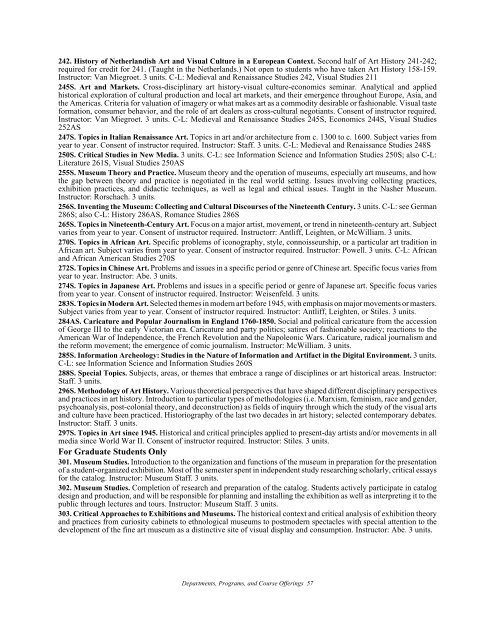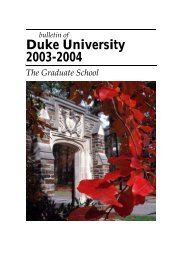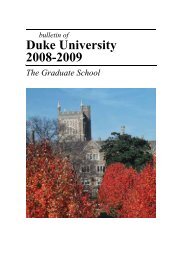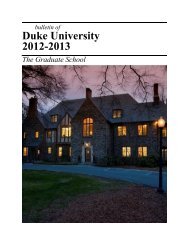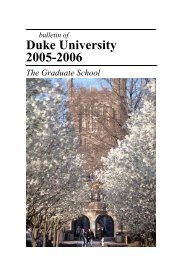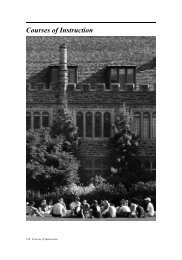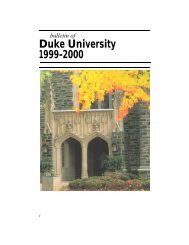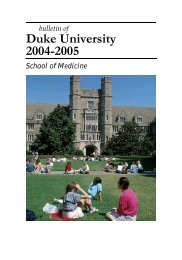Duke University 2009-2010 - Office of the Registrar - Duke University
Duke University 2009-2010 - Office of the Registrar - Duke University
Duke University 2009-2010 - Office of the Registrar - Duke University
You also want an ePaper? Increase the reach of your titles
YUMPU automatically turns print PDFs into web optimized ePapers that Google loves.
242. History <strong>of</strong> Ne<strong>the</strong>rlandish Art and Visual Culture in a European Context. Second half <strong>of</strong> Art History 241-242;<br />
required for credit for 241. (Taught in <strong>the</strong> Ne<strong>the</strong>rlands.) Not open to students who have taken Art History 158-159.<br />
Instructor: Van Miegroet. 3 units. C-L: Medieval and Renaissance Studies 242, Visual Studies 211<br />
245S. Art and Markets. Cross-disciplinary art history-visual culture-economics seminar. Analytical and applied<br />
historical exploration <strong>of</strong> cultural production and local art markets, and <strong>the</strong>ir emergence throughout Europe, Asia, and<br />
<strong>the</strong> Americas. Criteria for valuation <strong>of</strong> imagery or what makes art as a commodity desirable or fashionable. Visual taste<br />
formation, consumer behavior, and <strong>the</strong> role <strong>of</strong> art dealers as cross-cultural negotiants. Consent <strong>of</strong> instructor required.<br />
Instructor: Van Miegroet. 3 units. C-L: Medieval and Renaissance Studies 245S, Economics 244S, Visual Studies<br />
252AS<br />
247S. Topics in Italian Renaissance Art. Topics in art and/or architecture from c. 1300 to c. 1600. Subject varies from<br />
year to year. Consent <strong>of</strong> instructor required. Instructor: Staff. 3 units. C-L: Medieval and Renaissance Studies 248S<br />
250S. Critical Studies in New Media. 3 units. C-L: see Information Science and Information Studies 250S; also C-L:<br />
Literature 261S, Visual Studies 250AS<br />
255S. Museum Theory and Practice. Museum <strong>the</strong>ory and <strong>the</strong> operation <strong>of</strong> museums, especially art museums, and how<br />
<strong>the</strong> gap between <strong>the</strong>ory and practice is negotiated in <strong>the</strong> real world setting. Issues involving collecting practices,<br />
exhibition practices, and didactic techniques, as well as legal and ethical issues. Taught in <strong>the</strong> Nasher Museum.<br />
Instructor: Rorschach. 3 units.<br />
256S. Inventing <strong>the</strong> Museum: Collecting and Cultural Discourses <strong>of</strong> <strong>the</strong> Nineteenth Century. 3 units. C-L: see German<br />
286S; also C-L: History 286AS, Romance Studies 286S<br />
265S. Topics in Nineteenth-Century Art. Focus on a major artist, movement, or trend in nineteenth-century art. Subject<br />
varies from year to year. Consent <strong>of</strong> instructor required. Instructorr: Antliff, Leighten, or McWilliam. 3 units.<br />
270S. Topics in African Art. Specific problems <strong>of</strong> iconography, style, connoisseurship, or a particular art tradition in<br />
African art. Subject varies from year to year. Consent <strong>of</strong> instructor required. Instructor: Powell. 3 units. C-L: African<br />
and African American Studies 270S<br />
272S. Topics in Chinese Art. Problems and issues in a specific period or genre <strong>of</strong> Chinese art. Specific focus varies from<br />
year to year. Instructor: Abe. 3 units.<br />
274S. Topics in Japanese Art. Problems and issues in a specific period or genre <strong>of</strong> Japanese art. Specific focus varies<br />
from year to year. Consent <strong>of</strong> instructor required. Instructor: Weisenfeld. 3 units.<br />
283S. Topics in Modern Art. Selected <strong>the</strong>mes in modern art before 1945, with emphasis on major movements or masters.<br />
Subject varies from year to year. Consent <strong>of</strong> instructor required. Instructor: Antliff, Leighten, or Stiles. 3 units.<br />
284AS. Caricature and Popular Journalism in England 1760-1850. Social and political caricature from <strong>the</strong> accession<br />
<strong>of</strong> George III to <strong>the</strong> early Victorian era. Caricature and party politics; satires <strong>of</strong> fashionable society; reactions to <strong>the</strong><br />
American War <strong>of</strong> Independence, <strong>the</strong> French Revolution and <strong>the</strong> Napoleonic Wars. Caricature, radical journalism and<br />
<strong>the</strong> reform movement; <strong>the</strong> emergence <strong>of</strong> comic journalism. Instructor: McWilliam. 3 units.<br />
285S. Information Archeology: Studies in <strong>the</strong> Nature <strong>of</strong> Information and Artifact in <strong>the</strong> Digital Environment. 3 units.<br />
C-L: see Information Science and Information Studies 260S<br />
288S. Special Topics. Subjects, areas, or <strong>the</strong>mes that embrace a range <strong>of</strong> disciplines or art historical areas. Instructor:<br />
Staff. 3 units.<br />
296S. Methodology <strong>of</strong> Art History. Various <strong>the</strong>oretical perspectives that have shaped different disciplinary perspectives<br />
and practices in art history. Introduction to particular types <strong>of</strong> methodologies (i.e. Marxism, feminism, race and gender,<br />
psychoanalysis, post-colonial <strong>the</strong>ory, and deconstruction) as fields <strong>of</strong> inquiry through which <strong>the</strong> study <strong>of</strong> <strong>the</strong> visual arts<br />
and culture have been practiced. Historiography <strong>of</strong> <strong>the</strong> last two decades in art history; selected contemporary debates.<br />
Instructor: Staff. 3 units.<br />
297S. Topics in Art since 1945. Historical and critical principles applied to present-day artists and/or movements in all<br />
media since World War II. Consent <strong>of</strong> instructor required. Instructor: Stiles. 3 units.<br />
For Graduate Students Only<br />
301. Museum Studies. Introduction to <strong>the</strong> organization and functions <strong>of</strong> <strong>the</strong> museum in preparation for <strong>the</strong> presentation<br />
<strong>of</strong> a student-organized exhibition. Most <strong>of</strong> <strong>the</strong> semester spent in independent study researching scholarly, critical essays<br />
for <strong>the</strong> catalog. Instructor: Museum Staff. 3 units.<br />
302. Museum Studies. Completion <strong>of</strong> research and preparation <strong>of</strong> <strong>the</strong> catalog. Students actively participate in catalog<br />
design and production, and will be responsible for planning and installing <strong>the</strong> exhibition as well as interpreting it to <strong>the</strong><br />
public through lectures and tours. Instructor: Museum Staff. 3 units.<br />
303. Critical Approaches to Exhibitions and Museums. The historical context and critical analysis <strong>of</strong> exhibition <strong>the</strong>ory<br />
and practices from curiosity cabinets to ethnological museums to postmodern spectacles with special attention to <strong>the</strong><br />
development <strong>of</strong> <strong>the</strong> fine art museum as a distinctive site <strong>of</strong> visual display and consumption. Instructor: Abe. 3 units.<br />
Departments, Programs, and Course Offerings 57


